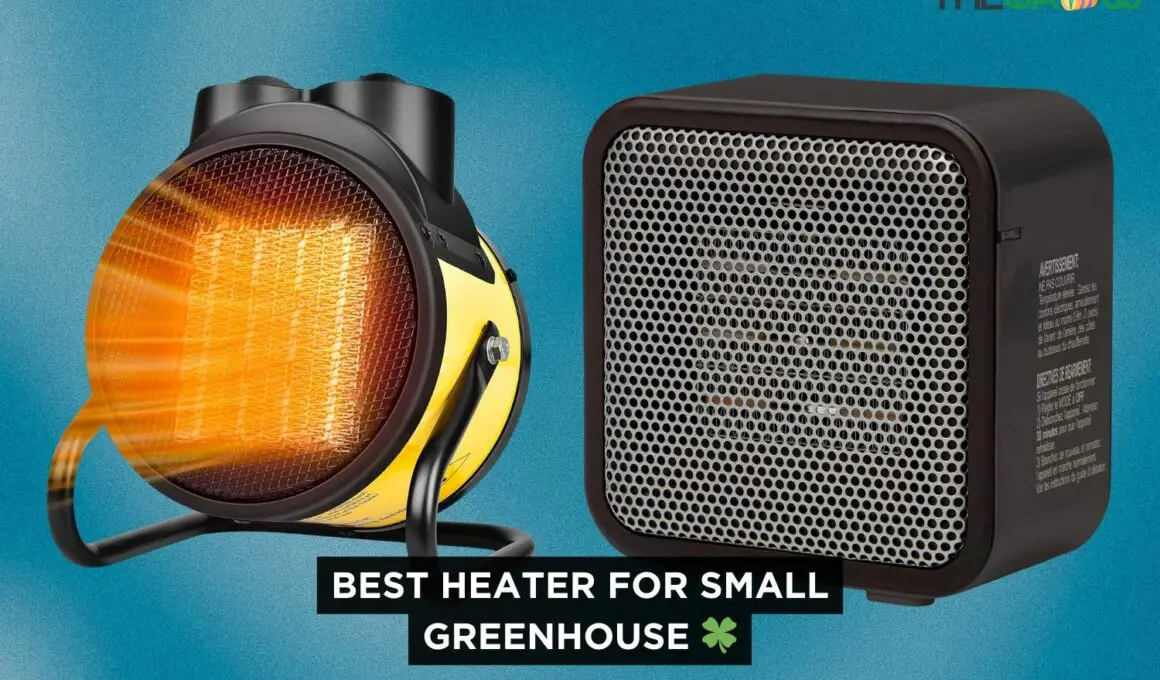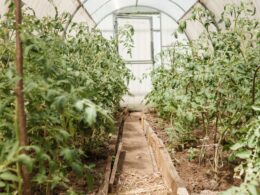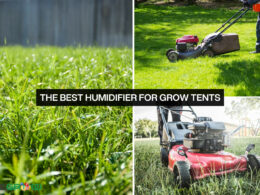In This Article Show
Maintaining a consistent temperature in a small greenhouse is vital for the plant’s health. The best way to do this is through a quality heating system, especially during the colder months when frost can seriously threaten vulnerable seedlings and plants.
A heater specifically designed for a small greenhouse can be the difference between a thriving plant oasis and a withering garden. When choosing a heater for a small greenhouse, it’s important to consider several factors. Size and heating capacity are crucial, as a heater that’s too small won’t maintain the desired temperature, while one that’s too large could overheat the space and waste energy.
The Best Heater for Small Greenhouses
- Best Overall: VIVOSUN Portable Greenhouse Heater
- Best for Quick Heating: HUNTINGOOD Space Heater
- Best Compact Heater: Amazon Basics Mini Heater
- Best Versatility: Dreyoo Greenhouse Buddy
- Best Durability: Dr. Infrared Greenhouse Heater
Other considerations include the type of fuel it uses, the distribution of heat, safety features, and the level of temperature control.
Energy efficiency is also a critical factor. An efficient heater can save money on fuel in the long run and contribute to a healthier environment by minimizing carbon footprint. It’s essential to look for a heater with a good balance between power and efficiency, ensuring that the greenhouse temperature is regulated without excessive energy wastage.
Top Heaters for Your Small Greenhouse
I’ve researched extensively to find the most suitable heaters for small greenhouses, ensuring your plants thrive in the optimum temperature regardless of the outside weather.
These products are chosen for their reliability, efficiency, and ability to maintain a consistent warmth. My selection aims to cater to various needs, whether you’re looking for electric, gas, or portable options.
Get Gardening For Beginners
Our new EBOOK shows newcomers and green thumbs alike a step by step guide to growing the garden of their dreams.
1. VIVOSUN Portable Greenhouse Heater

I’d recommend this heater as an efficient solution to keep your small greenhouse warm, based on my satisfactory experience with its performance and safety features.
Pros
- Rapid heating with flexible power settings
- Built-in safety cut-offs to prevent overheating
- Versatile and easily adjustable thermostat
Cons
- The highest temperature setting may not be very high
- Thermostat accuracy can be hit-or-miss
- Potentially short lifespan for thermostat
After setting up the VIVOSUN heater in my compact greenhouse, I noticed a quick and consistent rise in temperature, essential for preserving my delicate plants during cooler spells. Its ability to oscillate and the dual power mode enhanced its utility, depending on the level of warmth required.
Moreover, I found the design to be practical and safe. The heater stood stably, thanks to its bracket structure, and I was relieved that the automatic shut-off feature would safeguard against potential fire hazards. The digital thermostat was a bonus, allowing me to regulate the temperature without frequent manual adjustments.
Although the heater performed well, I did observe some issues with the thermostat after regular use. It struggled with accuracy occasionally, which meant I had to keep an eye on it to ensure my plants weren’t subjected to undesirable temperatures. Despite that, my overall experience was positive, and the heater proved to be a reliable heat source when it mattered most.
2. HUNTINGOOD Space Heater

I highly recommend the HUNTINGOOD Space Heater for anyone needing an effective heating solution for small spaces, given its quick heating capacity and safety features.
Get Gardening For Beginners
Our new EBOOK shows newcomers and green thumbs alike a step by step guide to growing the garden of their dreams.
Pros
- Rapidly warms the area with a 3-second heat-up
- Safety features prevent overheating
- Portable design with easy handling
Cons
- Uses more electricity than some alternatives
- Could benefit from a sturdier internal construction
- Lacks an outdoor use suitability despite claims
Just unpacked the HUNTINGOOD Space Heater from its box, and I could already tell by the design that this compact heater would make a convenient companion in my small greenhouse.
With a simple turn of the knob, the heater sprang to life, delivering warm air to every corner of the room, effectively banishing the chill within moments. Its light weight made repositioning a breeze—no cumbersome dragging involved.
The air from this heater feels like a blanket of warmth, creating a comfortable ambiance that’s especially welcoming during chilly mornings. While basking in its warmth, I noted how the fan’s gentle hum was not disruptive, blending seamlessly into the background noise.
Impressed by its quick action, I was equally satisfied to know that built-in safety measures are there to keep things in check, halting heat production the instant it senses the potential for overheating.
Reflecting on the utility costs, I did observe a noticeable increase in my electricity bill; however, this is a trade-off with any heater that delivers such rapid heating. I dashed my hopes of utilizing this heater indoors and outdoors when I read the manual, clarifying that it’s not suitable for outdoor use.
And while it’s sturdy enough, the internal components could do with additional support as per some users’ experiences.
In summary, the HUNTINGOOD Space Heater is a stellar choice if you seek a snug atmosphere in indoor spaces. It’s built to warm small areas quickly, has essential safety functions, and is simple to lug around. Although it might nudge your energy consumption upward and isn’t an outdoor solver, its performance indoors makes these points minor, and its advantages stand out.
3. Amazon Basics Mini Heater

I’d recommend this heater if you need a small, efficient heat source for personal use in your greenhouse.
Pros
- Heats up quickly for instant warmth
- Features a tip-over protection for safety
- Compact and lightweight for easy positioning
Cons
- Lacks temperature control options
- Only suitable for small, localized areas
- May not be adequate for cold climates or larger spaces
When I first used this heater in my small greenhouse, I was immediately impressed by how swiftly it warmed up my workspace. It’s perfect for keeping my plants cozy during those chilly mornings. The heater’s size is a nice fit, as it doesn’t take up much space, leaving more room for my greenery.
This unit’s safety features are certainly reassuring. The tip-over protection offers peace of mind, knowing that in case it gets knocked over, the heater will shut off automatically. With products like these, safety is paramount, and Amazon Basics has covered that base.
However, while it serves the intended purpose well, the lack of adjustable heat settings means it’s either on or off, with no middle ground. This could be a downside if you’re trying to maintain a specific temperature range.
Another point to consider is its effectiveness in larger areas – it’s not designed for that, and expecting it to keep a big space warm could lead to disappointment. Despite these limitations, the Amazon Basics Mini Heater meets the needs it’s designed for quite effectively.
4. Dreyoo Greenhouse Buddy

If you’re seeking a heater that can efficiently address the chill in your small greenhouse, this compact yet powerful unit might just be your go-to solution.
Pros
- Offers versatile heating options with a dual heat setting and a fan mode for different temperature needs.
- Comes with a digital thermostat that promotes precise temperature control to suit your plants’ environment.
- The portable design, complete with a handle and a sturdy base, allows for easy relocation and stable placement.
Cons
- The heater’s output may not suffice for spaces larger than its recommended coverage area of 120 sq ft.
- Some users have reported durability issues after a couple of months of use.
- The waterproofing is inadequate for wet conditions, as per user manual advice, which can be limiting for a greenhouse setting.
Using this Dreyoo heater has simplified climate control in my small greenhouse. Its manageable size doesn’t detract from its ability to warm the area rapidly. Observing the plants, I’ve noticed no adverse effects from temperature fluctuations, which speaks volumes about the heater’s consistency.
The digital heat thermostat included with this heater is a standout feature. It’s relieved me from the task of constant monitoring, as it effectively maintains the set temperature. The added thermohygrometer helps me keep a watchful eye on temperature and humidity, ensuring my plants thrive in the right conditions.
The mobility of this heater is something I highly value. I have repositioned it several times, depending on my setup changes, and the non-slip base has kept it firmly in place.
Its adjustable airflow direction also helps direct the heat exactly where it’s needed most. However, be mindful that despite its robust performance, it might struggle to keep up during harsher conditions if your space exceeds its coverage capacity.
5. Dr. Infrared Greenhouse Heater

If you’re seeking a dependable way to ward off the cold from your greenhouse, the Dr. Infrared Heater is an excellent choice based on my experience.
Pros
- Keeps plants at ideal temperatures with precise thermostat control
- Built to last with heavy-duty materials and water splash protection
- Lightweight and portable, making it convenient to move as needed
Cons
- Only one heat setting may limit flexibility for some users
- Might be too powerful for very small, enclosed spaces
- The initial cost might seem steep for budget-minded gardeners
Using this greenhouse heater has effectively managed the climate around my young plants. The robust construction gives me confidence it will last through multiple cold seasons. Its ease of portability proved handy when I rearranged my workspace, and plants thrived under the consistent warmth.
The heater’s single heat setting is potent, maintaining a steady environment for my plants without hassle. However, it’s worth mentioning that you won’t get the option to switch between multiple heating levels. This didn’t deter me, as the temperature around my greens need not fluctuate much.
A noticeable feature was the heater’s water splash protection design, ensuring that occasional watering mishaps didn’t put the heating element at risk.
Despite its strength, the heater works quietly in the background, not disturbing my peaceful greenhouse ambiance. Investing in this heater would be a smart move if you’re serious about protecting and nurturing your tender plants during colder spells.
Assessing Your Greenhouse’s Size and Heating Needs
Firstly, I evaluate the size of my small greenhouse to determine the heating power needed. It’s crucial to opt for a heater with the adequate BTU (British Thermal Unit) output to maintain a consistent temperature without wasting energy.
Fuel Type and Efficiency
| Fuel Type | Pros | Cons |
|---|---|---|
| Electric | Clean and easy to install | May cause high electricity bills |
| Gas | Cost-effective for larger spaces | Requires ventilation and upkeep |
| Paraffin | Inexpensive to run | Needs regular refueling and maintenance |
Choosing between electric, gas, or paraffin heaters involves considering the availability of these fuels and the operating costs associated with each.
Heater Features
I look for features that enhance usability and safety:
- Thermostat: Allows for precise temperature control.
- Fan-assisted: Improves heat distribution throughout the space.
- Safety cut-off: Essential to prevent overheating.
Durability and Maintenance
A heater’s build quality is vital for longevity in damp greenhouse environments. I seek out ones designed specifically for greenhouse conditions to ensure resistance against rust and corrosion. I also consider ease of maintenance and cleaning.
Environmental Considerations
I always consider the environmental impact of my heater choice, preferring options that offer higher efficiency and less pollution, aligning with my commitment to sustainable gardening practices.
Frequently Asked Questions
Which type of heater is most energy-efficient for a small greenhouse?
Electric infrared heaters are typically the most energy-efficient for small greenhouses. They convert nearly all the electricity they use into heat and can be focused on specific areas, reducing waste.
What economical options are available for heating a small greenhouse?
I recommend biofuel heaters or paraffin heaters as economical options. These can provide adequate heating at a lower cost compared to electric heaters, though you must consider fuel availability and venting requirements.
How can one effectively heat a mini greenhouse without overspending?
To avoid overspending, I suggest using bubble wrap insulation to retain heat and employ a small electric fan heater with a built-in thermostat for temperature control. This combination minimizes heat loss and reduces the need for constant heating.
Are there any heaters with thermostats that are suitable for small greenhouses?
Certainly, compact electric fan heaters with adjustable thermostats are well-suited for small greenhouses. They allow for precise temperature management and can be set to maintain optimal conditions for plant growth.
Can ceramic heaters be used in small greenhouses, and what are their benefits?
Ceramic heaters are appropriate for small greenhouses due to their ability to rapidly warm up space without causing humidity issues. Their built-in safety features also prevent overheating, making them a safe choice.
How practical are solar heaters for small greenhouses, and do they provide adequate warmth?
Solar heaters are incredibly practical for small greenhouses, especially in sunny locations. They harness free energy from the sun, reducing electricity costs, and can provide sufficient warmth during the day. However, backup heat may be required on cloudy days or at night.










